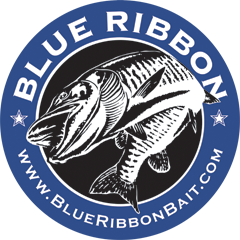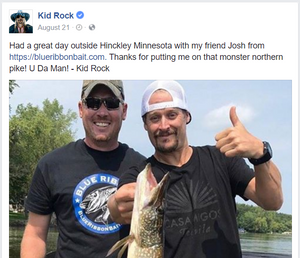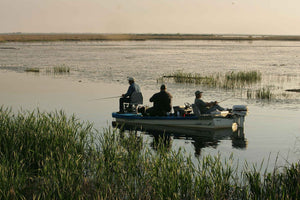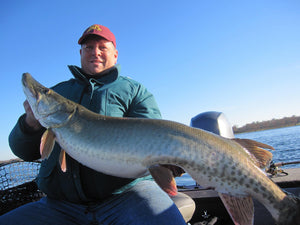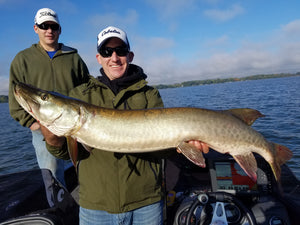Blog & Angler Education

Kid Rock Calls Upon Blue Ribbon's Owner Josh Stevenson for Fishing Trip 0
Detroit rocker Kid Rock squeezed in a fishing session after his show at Grand Casino in Hinckley last weekend and before headlining the Iowa State Fair.
Kid Rock played Grand Casino in Hinckley on 8/19/17 and held his private jet off Sunday afternoon so he could get in some fishing with Blue Ribbon Owner & Fishing guide Josh Stevenson before departing for another show in Iowa that night. Josh guided Kid Rock in the Pine City area Sunday morning.
But fishing was slow for the group, which included fellow musician Uncle Kracker.
“They were not biting,” Stevenson said in a Sunday evening phone call. He wanted to take Kid Rock to Lake Mille Lacs, but they didn’t have enough time.
With the short outing on the Snake River and adjoining Cross Lake just about finished, Stevenson asked Kid Rock if they could try one more spot. The move paid off: Kid Rock caught a northern pike estimated at 8 pounds.
“It was a lot of pressure because they weren’t biting,” Stevenson said, adding that “Kid Rock was patient and hard-working, persistent.”
Josh is available for half-day and full-day guide trips for Musky, Northern Pike, Bass, Walleye & more.
Josh's guiding availability is visible at www.MightyMusky.com
Shop Blue Ribbon's online store
Josh's news interview on Kare11:


Twin Cities Star Tribune article on Josh guiding for Kid Rock

Minnesota Outdoor News article
AM 1500 Radio- The Great Outdoors Interview on 8/23 (Josh begins at 21:08)
Josh's guiding availability is visible at www.MightyMusky.com
Shop Blue Ribbon's online store
- Expert shopapps Shop Adds

Late Summer Bass Fishing: ABC’s to Catching Big Bass 0
Late summer can be one of the best times to land the biggest bass of your life. But if you use the wrong tactics and gear, it can be one of the most frustrating times to fish. Countless lakes and rivers in parts of the Twin Cities Metro Area offer outstanding opportunities to catch Largemouths and Smallmouths alike from the season opener through well into the fall. To keep you in the action I’m offering some of my best strategies and techniques for chasing monster summer bass. Before you hit the waters, check out these tactics and bait suggestions.
For late summer bass, you have to know where to find them. Largemouths and Smallmouths are often deep and lethargic during this time of the year, and they’re also frequently starting to relocate and suspend at mid-depth ranges as forage begins to move. This is when a lot of professional anglers and tournament anglers start following the ABCs of summer fishing. The ABCs stand for aquatic vegetation, bridges, and current, three shortcuts to finding big fish.
I’ve learned through many years of chasing bass here on the waters of Minnesota and fishing many bass tournaments to know that these fish do not stop feeding. Bass often burn a lot of fuel, so they need to feed very often.
Aquatic Vegetation: Bass love lily pads, hyacinths, and other greenery because they hold forage such as baitfish and sunfish. Also they provide cover, shade and higher oxygen. I would look for edge irregularities, especially depth changes; brush, logs, or rocks with vegetation; or patches of greenery. My techniques and tackle include Topwater frogs over the top and through openings, flipping jigs and Flappin’ Hawgs into open holes; run shallow crankbaits along the outside edges. I use 40-to 65- pound braided Power Pro line for frogs and jigs; 15- to 20 pound fluorocarbon for crankbaits.
Bridges: Bass love cover, shade, and abrupt depth changes. Nearby rocks often hold forage. I constantly look for brush lodged on the upstream side of pilings, current breaks behind pilings and baitfish around pilings. I cast a spinnerbait or crankbait parallel to pilings. I also love fishing this area with a drop-shot rig with a finesse worm. Use 8- to 15- pound fluorocarbon line.
Current: Bass like moving water because it produces higher oxygen, washes in food, and usually creates cooler temperatures. I would look for eddies and protected calmer water; rocks, small islands, and other visible cover like stumps and logjams. I prefer to cast light jigs, plastic grubs, or Texas-rigged Senkos and Wacky worms upstream and let the current carry them into the quiet eddies. You can try working small buzzbaits across calmer areas, especially in early mornings or late evenings. I use 12- to 15- pound fluorocarbon line for strenth and visibility.
There’s no doubt the summer’s winding down, the kids are getting ready to return back to school and most of the bass on your favorite lake or river have seen it all by now. Now is the perfect time to also change gears and try something new or different. Bring some new life into your bass tactics and you never know---you might land that trophy bass into the boat.
- Josh Stevenson

Fishing Tournaments Will Make You a Better Angler 0
A lot of anglers have the misconception that to fish tournaments, whether it be bass, walleye, muskie, or even panfish, you have to be a highly qualified professional to compete. Although at the highest level of tournament fishing you should be fairly adept, I'd like to offer some tips that will help you get into fishing tournaments at any level. Hopefully this will make you a better angler for your everyday fishing as well. I will mainly focus on walleye tournaments, since that is what I fish most, but these tips would apply to all fish species tournaments.
A good way to explore fishing tournaments is to first fish a tournament as a co-angler with a professional. On the walleye side there are a couple of circuits that encourage this type of participation. A couple to check out are Cabela’s National Walleye Tour, (NWT), or the FLW. The concept is fairly simple; you as the amateur are matched with a different professional for each day of the fishing tournament. You work together as a team, and the weight of your catch goes with you into the next day, as you are paired up with a different professional. Most pros will help you with any questions you have, and if you have a basic understanding of how a rod and reel work, they will (in most cases) let you catch your share of the team’s total catch.
Fishing with pros has taught me more than any video I have seen, or any article I have read. Watch how your pro partner fishes---how they present their bait or lure, how they bring in their fish to the boat, how they net. Pay attention to what type of equipment and tackle they use during the fishing tournament, how they use their electronics, and how they use boat control to catch fish. It is also very important that you listen to your pro on what they want you to do, and how they want it done.
In these type of tournaments the pro will provide everything: rods, reels, bait, etc. All you need to bring is proper clothing, rain gear, your food and beverage (no alcohol though). It is customary to help the pro with some of the expenses, such as gas and bait. A small stipend is greatly appreciated. Most entry fees for co-anglers at these tournaments range from $200-$400. I believe this is money well spent for the type of education you can get out of this experience. Most of the pros I have fished with are very approachable and friendly, but it is crucial that you listen to them. After all, they are trying to earn a living by fishing tournaments.
If you are ready to start fishing tournaments on your own, there are a couple of basic things you need to know. First and foremost, although some tournaments require a minimum length boat of 16ft for safety reasons, you don’t need a $70,000 tournament boat outfitted with all of the latest electronics and gizmos to enjoy the tournament experience. I fished one tournament that was won by a father/son team that used a 17ft tiller style boat.
Second, most tournaments are team events, so find a good partner that has the same passion for fishing that you do. Keep in mind that teams are not just two guys. There are a lot of husband/wife, father/son, mother/daughter, brother/brother teams, and so on.
Next, consider which tournament(s) you would like to fish. A couple of state and regional circuits are the Minnesota Tournament Trail, (MTT), and the AIM Weekend Walleye Series, (AWWS). There are a few others too. These circuits usually consist of 4-8 qualifying events that lead into a championship tournament. You don’t have to fish every qualifier to get the tournament experience. Each tournament offers a cash payout to the top finishers, depending on how many teams have signed up. Most of the tournaments are one or two days in length, so you don’t need to take a week’s vacation to participate. Most fall on weekends, so plan on 2-4 days, including prefishing.
There are a couple of different formats for walleye tournaments: live weigh in, and catch and release. Catch and release is a fairly new concept. You are issued an SD card for your camera, a certified measuring board (like a Judge rule), and a score card to record the length of fish. When you catch a fish, you put it on a measuring board and your partner takes a picture of it to show the length. You then record that length on the score card which is converted to weight. It is a great concept and the wave of the future. This format will help protect the resource and isn’t subject to slot sizes and possession limits.
Another choice is 1 off fishing tournaments. There are many to choose from around the area. These tournaments are also team events. Some are two days in length, but most are only one day, so not a huge time commitment is needed. They offer very generous payouts and are generally held on popular walleye lakes. Again you don’t have to have all the latest and greatest equipment to participate. Skill levels range from intermediate to expert. For more information on all these fishing tournaments you can search the internet, check out some of the outdoor publications, or check with your local sporting good store or bait shop like Blue Ribbon Bait and Tackle.
Here are some basic tips for fishing your first tournament. After you and your partner have decided which tournament and body of water you want to fish, make sure you do plenty of prep work before you head out. This includes researching the body of water you will be fishing by consulting both electronic and paper maps. Note what type of structure it has, its water clarity, and predominant forage. DNR lake maps also provide a lot of helpful info, such as size of fish, stocking, and so on. Before you leave, make sure your gear is in order and working properly. Get fresh line on your reels, the correct tackle on board, and make sure your boat motor and trailer are in proper working order.
Pre-fishing is a very important way to prepare yourself for tournament success. Try to arrive a day or two (or more) in advance to get to know the body of water you'll be fishing. Before you launch your boat, check with the local bait shops to see what the dominant bait will be, the presentations that work best, and the areas the locals fish. Don’t expect to get specific information on spots, but anything will help. Once you reach the boat ramp don’t be afraid to talk to the locals. Be friendly with a smile. Also make sure you know what the weather will be. Is it cloudy? Or clear? What direction is the wind coming from? What is the water temp? These factors help determine what presentation will work best and help dictate which strategy will work for that day.
Once you are out on the water keep track of what is working and what is not. Don't be afraid to try something new if what you're accustomed to using isn’t working. If you are locating and catching fish, don’t linger on that spot too long, as you don’t want your competitors crowding in on you. And the more important point is that you need to have alternate spots in case that particular spot doesn’t work out during the tournament. Pay attention to what other boats are doing, both locals, and other competitors. Don’t worm in on their spots, but see what they are using for presentation and pay attention to what kind of boat control they may be employing. Make sure you and your partner are on the same page when it comes to making decisions on locations and presentations. You don’t want to be arguing about these things the day of the tournament.
Once you have completed your pre-fishing, make sure you arrive early to the fishing tournament rules meeting, usually the night before the tournament. This is a good time to network with other competitors and get to know people. Once the rules meeting starts, pay attention to the rules. You don’t want to be penalized fish or get disqualified because of inattention. Listen to what other competitors are talking about. Some of the information you can use, some of it might just be to throw competitors off their game. In turn don’t give out any specific information you have garnered, but be friendly on general information. You may see these competitors at other tournaments so it may benefit you to have relationships with other people.
Apply what you have learned pre-fishing in the actual fishing tournament. Be patient, don’t get stressed out if things aren’t working out as planned, and be positive. Learn by your mistakes and file away what worked for the next time. After the tournament is over talk to the other anglers to see what worked for them, and in turn what worked for you. Most anglers will give you more specific information once the fishing tournament is over and you can use this for the next tournament, or the next time you go out fishing for fun.
Following these basic tips will hopefully make you a better angler, enhance your fishing experience, and boost your confidence in all of your fishing endeavors.
- Josh Stevenson
Baby Beaver Musky Lure: Hard to Categorize, Hard to Resist 0
A lure that both defies categorization and triggers giant musky strikes has a tendency to get people talking. Such is the case with the Baby Beaver lure from Beaver’s Baits. We’ve never seen anything like it!
Says Brian Boyum, inventor of the Baby Beaver, “I wanted to create something different—not another crankbait or topwater or bucktail. My bait swims totally under water. And I haven’t seen any other baits on the market that have the up and down movement of the Baby Beaver. I think it’s good when dealers tell me they don’t know what category to put it in!” And the feedback Brian’s gotten thus far on its performance has been “absolutely incredible.”
The bait's body is tied with deer hair (about one full deer tail per Baby Beaver XL) and is connected with split rings. The rubber tail is molded onto the hook and is attached to the bait with a split ring, making it replaceable. Brian also added the option of turning the bait into a bucktail by adding blades to the front eyelet. “I thought, we’ve got a very unique bait here. Let’s give fishermen the option to run this as a bucktail too. It has some kick to it. The body twitches, the tail kicks, and then there’s the thump of the blades...all using the same lure.” Check out the amazing swimming action of the Baby Beaver on BeaversBaits.com. At the end of the video, right before the musky strikes, you can watch the rod tip action Brian uses to work this bait.
First Inspirations
It was the popular “Musky Fever” that originally led to Brian Boyum’s interest in creating lures. He started out hand-carving crankbaits, top water baits, and tying bucktails for his own personal use. But he soon found it to be too time-consuming, as he was already working full-time as an electrical engineer. At that point, he could not justify spending all that additional time on lure making.
Years later, however, Brian came upon an idea that he knew he simply had to pursue. A good friend and fellow musky angler in northern Minnesota had contacted the DNR for regulations on squirrel hunting, and upon receiving the green light, he went ahead and shot a few. With each squirrel, he then inserted a wire ring through the nose, with a leader attached, and ran another leader to the squirrel’s belly, into which he stabbed a treble hook. He then fished that dead, limber squirrel, and caught two fish in an hour.
Brian knew there had to be a way to mimic that presentation using artificial components. It wasn’t long before he had assembled a prototype. But when he fished it, he didn’t get the results he wanted. In retrospect, he believes the fish just weren’t biting that day. But that slow day led to his decision to shelf the bait.
Persistence Pays Off
Five years went by. And the party responsible for returning the Baby Beaver to the water? It was Brian’s stepson, Cody. As Brian puts it, “he kept hounding me for it, and finally I gave in and said he could go fish it.” Cody went fishing with the same family friend who had been throwing the dead squirrels, and who had also raised a nice fish the day before, so they knew right where to go. That day, Brian received a phone call from Cody who reported, “I just crushed a 49” on the Baby Beaver!” It was only four casts in, with the prototype on the end of his line.
After that phone call, Brian made four more prototypes in different colors. The first time he headed out with a friend to try out the bait, it again took only four casts to land a musky—a 53.5”! He cleaned up that weekend with another two 49’s and two 48’s. Brian went home and jumped into the next stages of lure production, researching different plastics and the how-to’s of casting and making molds.
Amazingly, the current Baby Beaver is nearly identical to the original prototype. Only a few physical characteristics evolved, such as the addition of a face and a unique tail, both of which Brian sculpted and casted to create molds.
Balance? What Balance?
As any lure-maker knows, it is challenging to strike a satisfying balance with your time. Brian says simply, ”There is no balance. I punch out from my ‘real’ job and then punch in to my second job. It wears on a person...I go to bed, get up, and do it all over again. But you’re not going to be successful at something sitting on the couch. I’m going for it.”
In order to get things moving a bit more quickly, Brian invented a machine that holds in place the deer hair and the piece he’s working on, but is also capable of spinning, so he can turn the piece and move it in and out, while the thread and tensioner are stationary. “Without the machine, I wouldn’t have the bait out on the market. Before using the machine, it took me an entire night to build one bait. Now I put the hair in there, push the pedal, and it’s all motorized. It’s pretty cool.” Brian estimates that when he sits down and ties without interruptions, he can tie 4 XLs or 6 Originals in 2-3 hours. But because tying these lures, even with the machine, is prohibitively time-consuming, (especially when he has more ideas in the hopper and more prototypes in the testing stages) Brian is talking with a few companies about getting the Baby Beaver mass-produced. “I’d rather not be sitting in my basement tying lures all summer and all winter long. Who wants to do that?”
There are plenty of bright spots too. In addition to the positive feedback he’s received, Brian reports that the most fun part of this lure-making venture has been the people he gets to meet. “These people have been in the industry for many, many years. And they’ve been great. I started this because I wanted to have fun, and to help people on the water. That’s what it’s all about for me.”
Specifications
The Baby Beaver is available in two sizes: the Original is 12” long, weighs 3.5 oz and uses 6/0 hooks. The Baby Beaver XL is 14.5” long, weighs 6 oz, and uses 8/0 hooks. The lure is constructed of plastic with .062 wire molded into each body piece.
To work the Baby Beaver, Brian advises using “a steady reel retrieve, moving the rod tip about a foot as you reel. It’s similar to using a jerkbait, but you don’t jerk as hard. As the operator, you have to make this bait come to life. You can do a straight retrieve and the bait will move, but it’s really up to you to make it come to life by twitching the rod as you reel.” Now, what musky angler can resist a challenge like that?!
- Josh Stevenson

Why Fishing Matters 0
Did you know that our great state of Minnesota is the third most-popular inland fishing destination in the country?! What a great resource---11,842 lakes and 8,000 miles of fishable rivers and streams. And even if you don’t have a boat, it’s not a problem. There are hundreds of public fishing piers, docks and platforms statewide. (You can find more information from the DNR's page "Find a Fishing Pier" for these on-shore options.)
According to the MN DNR, roughly 500,000 anglers fished the Minnesota Fishing Opener on May 9th. That is a large number, but it is only a third of the 1.5million anglers who will be licensed this season.
The economic impact from these anglers is significant. Fishing contributes nearly $2.4 billion to the state's economy in direct retail sales, ranking Minnesota fourth in the nation for angler expenditures. The U.S. Fish and Wildlife Service estimates that each angler spends about $1,500 annually. This in turn supports 35,400 jobs statewide.
Beyond the benefits to our economy, fishing is fun! Anglers of all ages and backgrounds are drawn to this pursuit because of the challenge, the relaxation, the thrill of the catch and the joy of being outdoors. Fishing is also a great way to build a strong respect for nature, and is a ready made opportunity for parents to spend time with their kids and make memories in a natural setting.
Wherever you live in Minnesota, there are likely plenty of waterways nearby to explore. So instead of staying inside, unplug and go fishing! It’s good for the soul, our economy, and it’s enjoyable---a win, win, win.
- Josh Stevenson

Tips for Musky Lure Gift Giving 0
Giving a musky lure as a gift? Here are a few recipient-tailored hints to help you avoid some potential snags...especially when the gift you're giving includes sharp hooks.
YOUR BOSS: DO wrap the musky lure in bubblewrap or similar packaging with adequate cushion/protection. Include a “sharp hooks” warning on the outside of the package in case it’s opened when you’re not around. If you are there for the big reveal, be prepared to listen to lots of fish stories, from anyone and everyone standing nearby. Make the best use of story time and holiday spirit by suggesting a team building event with a local fishing guide. Many guides can rent a pontoon or sub-contract other guides to accommodate larger groups of people. Ice fishing would be another possibility for a larger group. Think you can out-fish your Administrative Assistant? How about Sue from Accounting? Fishing competitions among co-workers can be a blast.
DON’T wrap the musky lure in one layer of bargain bin wrapping paper and leave it on his/her desk. Boss’s Christmas present + hand injury ≠ raise.
SIGNIFICANT OTHER: DO see wrapping instructions above. Consider attaching travel brochures from new and exciting musky fishing destinations. This article from In-Fisherman offers some great possibilities. Musky fishing plus romantic getaway? Win-win!
DON’T give a musky lure hoping your SO won’t want it and you’ll get it by default. Sharp hooks and plastic can only scream “I love you,” to the right person.
FISHING BUDDY: DO temporarily transfer all hopes and dreams for The Big One to your buddy. Maybe they’ll even catch their personal best. You are such a great friend.
DON’T expect credit in the photo of the new State Record fish your buddy might catch using the lure you gave him/her. If the very thought of that makes your eye twitch, just save yourself the torture and buy a second lure for you to keep. You’re still a great friend.
KIDS: (Seriously? No, we are not promoting this idea. But we acknowledge desperate times, desperate measures, and all that...) DO: Remove all hooks and provide constant adult supervision. Many lures contain lead, and you don’t want any part of a fishing lure, lead-laden or not, to ever go into a child’s mouth. That being said, on the days you can’t get out on the water next summer, kick back and enjoy hearing your child tell their own fish stories while splashing with their new hookless lures in a wheelbarrow or pool full of water. It may pique their interest in one day joining you in the boat.
DON’T admit you forgot to go to Target and had to go shopping in your tacklebox. Stick to the story. Hey, you had this planned all along.
YOURSELF: DO take a few moments to envision the surface boil, thick back, tea saucer-sized eyes, monumental fight and photo enlargement you’ll frame and hang on your living room wall. Maybe you’ll even spring for a replica mount. All thanks to this new lure. Awesome.
DON’T waste any more time reading this. Go shop online at BlueRibbonBait.com. You get 20% off (online code: winter20) through December!
- Josh Stevenson
